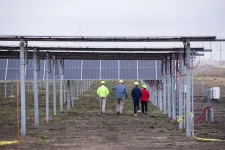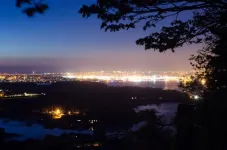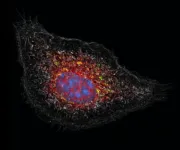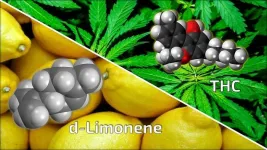(Press-News.org) A new lab assay developed by researchers at Fred Hutch Cancer Center could make diagnosis and treatment of small-cell lung cancer and non-small cell lung cancer easier.
The blood-based test, also called a “liquid biopsy,” can detect differences between types of lung cancer by examining patterns in cell-free tumor DNA in blood samples. It’s a desirable option for detecting small-cell lung cancer (SCLC) as standard needle biopsies fail due the number of smaller tumors typically present and the variety of tumor subtypes that indicate different treatment pathways.
“There is a deep need for blood-based assays that define subtypes in SCLC,” said Fred Hutch SCLC researcher David MacPherson, PhD, who co-led the work with Fred Hutch computational biologist Gavin Ha, PhD. “This new method is a step towards assays that would allow us to test and monitor disease, detect when it transforms into a different lung cancer type, and identify potential treatment targets even when standard biopsies aren’t an option.”
Such an assay could help oncologists tailor SCLC treatment when new, targeted strategies reach the clinic, and help them monitor patients for recurrence. In addition, it could detect when a patient’s disease has switched from non-small cell lung cancer (NSCLC) to SCLC, which can occur after cancer cells gain resistance to certain targeted therapy and help guide a patient's prognosis and inform new treatment strategies. Similar assays could also be used to improve clinical trials, helping identify trial candidates or providing researchers with information about why a certain patient may or may not respond to treatment.
To build the new assay, the research team developed a targeted strategy analyzing pre-clinical mouse models using human tissue in which cell-free tumor DNA was easier to sift out from DNA released by healthy cells. They found that the assay performed well when predicting whether DNA had come from an NSCLC or SCLC tumor, suggesting that their approach has potential for detecting when a patient’s tumor transforms from NSCLC to SCLC.
“Our approach demonstrates that a full-featured circulating tumor DNA assay has the potential to classify clinical subtypes driven by transcriptional programs,” said Ha, an associate professor in the Herbold Computational Biology Program at Fred Hutch. “This approach is especially important for SCLC and other tumors that may not have genetic mutations that can inform treatment decisions. The assay expands the boundaries for potentially using circulating tumor DNA to improve treatment selection and cancer management."
According to the American Cancer Society, 10-15% of all lung cancers are SCLC; an aggressive disease that is prone to metastasize or spread. About 238,340 people were diagnosed with lung cancer in the U.S. in 2023, and about 14% of them had SCLC. Most patients are diagnosed with late-stage disease and as few as 6% are alive five years after diagnosis.
This work was supported by the National Institutes of Health, the Kuni Foundation and the Conquer Cancer Foundation.
###
Media contact:
Heather Platisha
hplatisha@fredhutch.org
Fred Hutchinson Cancer Center unites individualized care and advanced research to provide the latest cancer treatment options while accelerating discoveries that prevent, treat and cure cancer and infectious diseases worldwide.
Based in Seattle, Fred Hutch is an independent, nonprofit organization and the only National Cancer Institute-designated cancer center in Washington. We have earned a global reputation for our track record of discoveries in cancer, infectious disease and basic research, including important advances in bone marrow transplantation, immunotherapy, HIV/AIDS prevention and COVID-19 vaccines. Fred Hutch operates eight clinical care sites that provide medical oncology, infusion, radiation, proton therapy and related services. Fred Hutch also serves as UW Medicine’s cancer program.
END
A study in Science Advances suggests liquid biopsy could detect and monitor aggressive small cell lung cancer
Targeted new blood-based assay detects different types of small-cell lung cancer using patterns in cell-free DNA, Fred Hutch researchers find
2024-04-10
ELSE PRESS RELEASES FROM THIS DATE:
New drug prevents flu-related inflammation and lung damage
2024-04-10
(MEMPHIS, Tenn. – April 10, 2024) Infection with the influenza virus leads to lung injury through inflammation over-activation that causes collateral damage to cells required for breathing. Such damage can be life-threatening, but scientists have a new preventative treatment. A team from St. Jude Children’s Research Hospital, University of Houston, Tufts University School of Medicine and Fox Chase Cancer Center created a drug that can prevent flu-induced lung injury. In a mouse model, the ...
Taking on the global challenge of hidden hunger
2024-04-10
COLUMBIA, Mo. — More than 2 billion people suffer from hidden hunger, a form of malnutrition where individuals lack essential micronutrients — like vitamins and minerals — even though they consume what appears to be an adequate amount of calories.
University of Missouri researcher Kiruba Krishnaswamy is focused on tackling this global challenge. She recently received a five-year, $532,000 Early Career Development (CAREER) award from the National Science Foundation (NSF) — the NSF’s most prestigious award for early-career faculty — in support of her project titled ...
Engineers making a better, more profitable grid for distributing solar power
2024-04-10
AMES, Iowa – If you’re the Midcontinent Independent System Operator – the organization that manages the flow of high-voltage electricity across a central stripe of the U.S. and Canada, from Manitoba, Michigan and Minnesota through Iowa and all the way to Louisiana – you want energy supplies to meet the energy demands of 45 million people.
“We make sure the right amount of electricity is generated and transmitted to our member utilities,” says the regional grid operator’s website.
Balancing power supply and demand is complicated these days. Electricity is no longer exclusively generated by power plants using coal- or natural ...
Initiative increases awareness of the threats posed by light pollution to the global ocean
2024-04-10
Scientists, policy makers, and marine and environmental professionals across the world are being encouraged to sign up to a new initiative highlighting some of the global threats posed by light pollution.
The Global Ocean Artificial Light at Night Network (GOALANN) has been launched today at the United Nations Ocean Decade Conference in Barcelona.
It has been established by ecologists, oceanographers and social scientists who have spent more than a decade studying the impact of light pollution on the ocean, and the many species living in or near it.
The GOALANN network aims to expand on the impact of that work, unifying research groups ...
How the body switches out of “fight” mode
2024-04-10
Joint press release of Charité and Uniklinikum Erlangen
Cortisone and other related glucocorticoids are extremely effective at curbing excessive immune reactions. But previously, astonishingly little was known about how they exactly do that. A team of researchers from Charité – Universitätsmedizin Berlin, Uniklinikum Erlangen and Ulm University have now explored the molecular mechanism of action in greater detail. As the researchers report in the journal Nature,* glucocorticoids reprogram ...
Physicists discover a novel quantum state in an elemental solid
2024-04-10
Physicists have observed a novel quantum effect termed “hybrid topology” in a crystalline material. This finding opens up a new range of possibilities for the development of efficient materials and technologies for next-generation quantum science and engineering.
The finding, published in the April 10th issue of Nature, came when Princeton scientists discovered that an elemental solid crystal made of arsenic (As) atoms hosts a never-before-observed form of topological quantum behavior. They were able to explore and image this ...
Researchers show chemical found naturally in cannabis may reduce anxiety-inducing effects of THC
2024-04-10
FOR IMMEDIATE RELEASE
A Johns Hopkins Medicine-led research team has added to evidence that a chemical found naturally in cannabis (also known as marijuana) can — in the right amounts — lessen the anxiety-inducing effects of tetrahydrocannabinol (THC), the primary psychoactive sister chemical found in cannabis. The finding has the potential to advance the medicinal use of THC, and reduce the risks of its recreational use in some people.
The substance, called d-limonene, is one of the most abundant terpenes, or essential oils, in the cannabis plant, and has shown promise in rodent studies in reducing anxiety behaviors. However, there has ...
AI-powered ‘sonar’ on smartglasses tracks gaze, facial expressions
2024-04-10
ITHACA, N.Y. – Cornell University researchers have developed two technologies that track a person’s gaze and facial expressions through sonar-like sensing. The technology is small enough to fit on commercial smartglasses or virtual reality or augmented reality headsets, yet consumes significantly less power than similar tools using cameras.
Both use speakers and microphones mounted on an eyeglass frame to bounce inaudible soundwaves off the face and pick up reflected signals caused by face and eye movements. ...
Newly found genetic variant defends against Alzheimer’s disease
2024-04-10
NEW YORK, NY (April 10, 2024)--Columbia researchers have discovered a genetic variant that reduces the odds of developing Alzheimer’s disease by up to 70% and may be protecting thousands of people in the United States from the disease.
The discovery of the protective variant, which appears to allow toxic forms of amyloid out of the brain and through the blood-brain barrier, supports emerging evidence that the brain’s blood vessels play a large role in Alzheimer's disease and could herald a new direction in therapeutic development.
“Alzheimer’s disease may get started with amyloid deposits in the brain, but ...
Serious flu damage prevented by compound that blocks unnecessary cell death
2024-04-10
As lung cells are killed by the influenza virus, they burst open, releasing molecular signals that trigger the immune cells that can combat the infection. This strategy can be an important red flag that something is wrong; however, if one cell death response, called necroptosis, continues unchecked, it can cause life-threatening injury to lung tissue. In a study published April 10 in the journal Nature, Tufts University School of Medicine scientists and collaborators present a newly developed compound ...
LAST 30 PRESS RELEASES:
The (metabolic) cost of life
CFRI special issue call for papers: New Frontiers in Sustainable Finance
HKU Engineering scholar demonstrates the smallest all-printed infrared photodetectors to date
Precision empowerment for brain "eavesdropping": CAS team develops triple-electrode integrated functional electrode for simultaneous monitoring of neural signals and chemical transmitters during sleep
Single-capillary endothelial dysfunction resolved by optoacoustic mesoscopy
HKU three research projects named among ‘Top 10 Innovation & Technology News in Hong Kong 2025’ showcasing excellence in research and technology transfer
NLRSeek: A reannotation-based pipeline for mining missing NLR genes in sequenced genomes
A strand and whole genome duplication–aware collinear gene identification tool
Light storage in light cages: A revolutionary approach to on-chip quantum memories
Point spread function decoupling in computational fluorescence microscopy
BacPhase: Long-insert paired-end sequencing for bin marker construction and genome phasing
GmWOX1 regulates the mediolateral polarity of compound leaves in soybean
ChargeFabrica: An open-source simulation tool that aims to accelerate search for high performance perovskite solar cells
High levels of ADAR overexpression induce abundant and stochastic off-target RNA editing in rice protoplasts
On-demand upgraded recycling of polyethylene and construction of sustainable multifunctional materials based on the "LEGO" strategy
New "Stomata in-sight" system allows scientists to watch plants breathe in real-time
Anorexia nervosa may result in long-term skeletal muscle impairment
Narrative-based performance reviews deemed fairest by employees
New insights reveal how advanced oxidation can tackle emerging water pollutants
New review shows how biomass can deliver low-carbon gaseous fuels at scale
Climate change is quietly rewriting the world’s nitrogen cycle, with high stakes for food and the environment
Study finds SGLT-2 inhibitors linked to lower risk of diabetic foot nerve damage
Microbes may hold the key to brain evolution
Study examines how the last two respiratory pandemics rapidly spread through cities
Gender stereotypes reflect the division of labor between women and men across nations
Orthopedics can play critical role in identifying intimate partner violence
Worms as particle sweepers
Second spider-parasitic mite described in Brazil
January 2026 issues of APA journals feature new research on autism, pediatric anxiety, psychedelic therapy, suicide prevention and more
Private equity acquired more than 500 autism centers over the past decade, new study shows
[Press-News.org] A study in Science Advances suggests liquid biopsy could detect and monitor aggressive small cell lung cancerTargeted new blood-based assay detects different types of small-cell lung cancer using patterns in cell-free DNA, Fred Hutch researchers find






